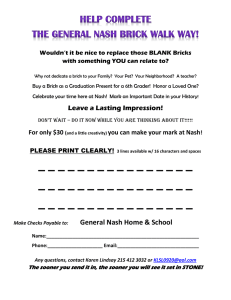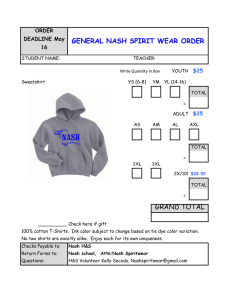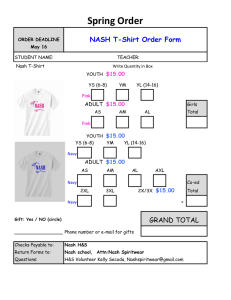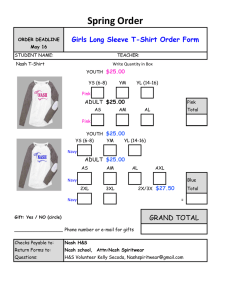VINO Presentation Common Audit Faults
advertisement
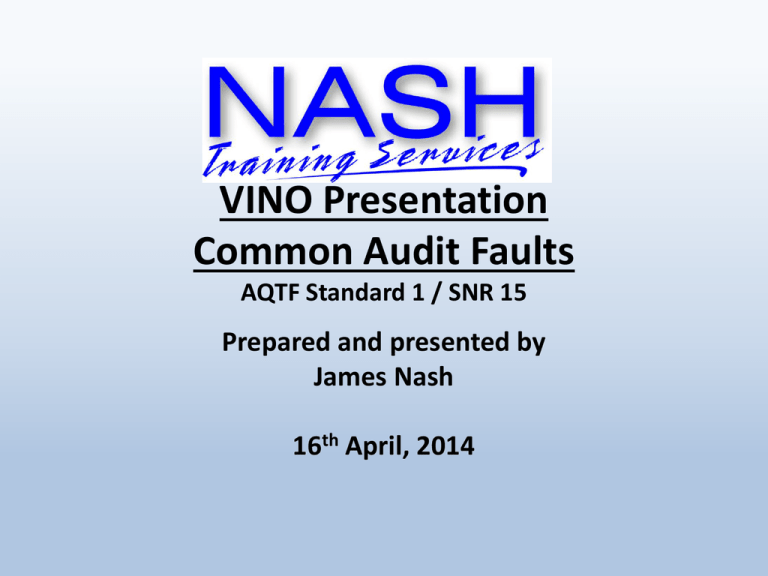
VINO Presentation Common Audit Faults AQTF Standard 1 / SNR 15 Prepared and presented by James Nash 16th April, 2014 The Audit Process • Those who have been through an audit understand the implications behind having identified non-compliances. This takes time, money, and can cause stress and pressures that can be avoided. • ASQA rules require rectification within 20 working days • VRQA require a plan for rectification and evidence to be supplied as required. Copyright © 2014 Nash Training Services 2 Common Audit Faults • Emphasis on compliance has increased across all standards and the need to regularly review and monitor implementation of RTO processes is now required. • While all standards are critical the most common issues seen at audit surround AQTF Standard 1 / SNR 15 – Affects the quality of delivery and assessment – These issues require more than just fixing a policy Copyright © 2014 Nash Training Services 3 Common Audit Faults • I have noticed continuing issues surrounding the following: – Strategies for training and assessment – Trainer files – Assessment documentation – Consistent information within RTO documentation Copyright © 2014 Nash Training Services 4 ASQA Statistics • Current statistics from ASQA relating to audit outcomes are available: o 77% of RTOs were found non compliant when audited by ASQA in 2012-13 o 85% of RTOs were found non compliant in their assessment requirements, and o 91 RTOs had their re-registration cancelled by ASQA in 2011-13. • ASQA has taken the decision to cancel/suspend the registration or to refuse the registration of 165 individual existing RTOs Copyright © 2014 Nash Training Services 5 ASQA Statistics In reviewing the outcomes of ASQA audits between July 2012 and December 2013 only 23 per cent of RTOs were compliant with the requirements of SNR 15 at an initial audit (including re-registration, extension to scope or monitoring audits). While another 53 per cent of RTOs were able to provide sufficient evidence of compliance with SNR 15 during the rectification period, some 20 per cent of RTOs remain non-compliant with key requirements relating to training and assessment after this period. (Taken from ASQA website) Copyright © 2014 Nash Training Services 6 ASQA Statistics • Audits of existing RTO’s 1 July 2012 – 30 June 2013: SNR Initial Audit Rectification Audit 15.1 78% 91% 15.2 46% 78% 15.3 54% 79% 15.4 52% 80% 15.5 26% 74% Copyright © 2014 Nash Training Services 7 Continuous Improvement (AQTF 1.1 / SNR 15.1) • AS the ASQA statistics indicate this is not a major concern for most RTO’s. - Ensure that your documented processes are being implemented as required - Ensure evidence of reviews, validation, and other activities are available - Ensure that there is evidence demonstrating how the improvements are identified and actioned! Copyright © 2014 Nash Training Services 8 Strategies for Training & Assessments (AQTF 1.2 / SNR 15.2) • Must be a ‘roadmap’ for the delivery and assessment of the qualification. Remove any assumptions of knowledge or information about how the course is being delivered. • Ensure current information is maintained within the strategies: - Unit codes - Durations and schedules (Student contact hours) - Entry requirements - Assessment methods - Staffing details Copyright © 2014 Nash Training Services 9 Strategies for Training & Assessments (AQTF 1.2 / SNR 15.2) • Must include specific details of delivery & assessment arrangements to ensure consistent implementation. This includes details on: - how the learning will be imparted - Details of schedules / timetables and how they are set up - Who is involved in the delivery and assessment process - Any specific location / equipment details Copyright © 2014 Nash Training Services 10 Strategies for Training & Assessments (AQTF 1.2 / SNR 15.2) • Include details on the order of delivery – identify how any unit pre-requisite requirements are met. • Include information on how LL&N issues are addressed. • Include details of how the implementation of the strategy for training and assessment will be monitored. • Legislation that is involved in the delivery and assessment process should be included – be specific. Copyright © 2014 Nash Training Services 11 Strategies for Training & Assessments (AQTF 1.2 / SNR 15.2) • Industry Consultation and evidence of this occurring must be available • Different strategy for a different delivery modes • Changed delivery and assessment arrangements may require client specific strategies. Copyright © 2014 Nash Training Services 12 Premises: (AQTF Standard 1.3 / SNR15.3) OHS requirements of premises... – Meet the Building Code of Australia (ASQA Fact Sheet Health and safety requirements for educational premises ) – Address matters of student safety (VRQA Guideline 4.3) • Classroom based delivery: – 9B Certificate or Certificate of Occupancy (Premises and Council dependant) Copyright © 2014 Nash Training Services 13 Premises: (AQTF Standard 1.3 / SNR15.3) • Workplace based delivery: – How do you ensure the Workplace has suitable facilities and equipment? • Confirming suitability of premises prior to commencing training • Checklist for required equipment / resources Copyright © 2014 Nash Training Services 14 Learning Resources: (AQTF Standard 1.3 / SNR15.3) • Ensure appropriate resources are available for all units within each course. • Documented in the strategy for training and assessment • Clearly reference learning materials in session plans. • Map learning resources to clearly identify that the learning materials are covering all required content. Copyright © 2014 Nash Training Services 15 Trainer Files: (AQTF Standard 1.4 / SNR15.4) • - Trainer files should be set up and made up of: Signed and dated resume Verified copies of all qualifications Skills matrix / Mapping document Evidence of professional development activities Copyright © 2014 Nash Training Services 16 Trainer Files: (AQTF Standard 1.4 / SNR15.4) • Demonstrating vocational competence: – Staff Matrix documents must include sufficient details to demonstrate vocational competence • Must be completed to the unit level • Do not cut and paste the same information for each unit of competency • Not to be a summary of the resume • Include specific tangible references to experience and where the skills and knowledge have been applied in a vocational context Copyright © 2014 Nash Training Services 17 Trainer Files: (AQTF Standard 1.4 / SNR15.4) • Professional Development Activities: - Should be directed and managed by the RTO to ensure appropriate activities are undertaken - A yearly PD plan is a good idea - Ensure evidence of PD activities are available Copyright © 2014 Nash Training Services 18 Assessment Instruments: (AQTF Standard 1.5 / SNR15.5) Assessment instruments do not meet the principles of assessment (fair, flexible, valid, reliable) or the rules of evidence (validity, sufficiency, authenticity, currency) Assessment instruments do not provide sufficient information / instructions to students or assessors to ensure consistent implementation can occur Copyright © 2014 Nash Training Services 19 Assessment Instruments: (AQTF Standard 1.5 / SNR15.5) • Ensure student / trainer instructions are detailed enough to ensure consistent implementation can occur. - Include all details related to completing the task including: - Include the context and conditions of assessment. This should include details on any real or simulated workplace environments, test conditions, and specific equipment / resources that may be required (i.e. computer, software or printer requirements, specific photographic equipment). Copyright © 2014 Nash Training Services 20 Assessment Instruments: (AQTF Standard 1.5 / SNR15.5) - Clearly describe the evidence to be submitted / collected Ensure the student has all information required to complete the task (especially in role plays / case studies) • Mapping documents must be completed appropriately to include all aspects of the unit of competency. Ensure required skills & knowledge, and critical aspects are mapped to the assessment tasks. i.e. specific number of times, over a period of time, consistent application, etc Copyright © 2014 Nash Training Services 21 Assessment Instruments: (AQTF Standard 1.5 / SNR15.5) • Inconsistent implementation of assessment tasks. Changes to the assessment process implemented by assessors. • Customisation of assessments to suit specific assessment methods of the RTO. Do not provide options as they are a separate assessment method. Copyright © 2014 Nash Training Services 22 Assessment Instruments: (AQTF Standard 1.5 / SNR15.5) • Observation checklists / Practical Demonstrations – The performance criteria should not be used as the checklist for a demonstration. – The checklist should be written using ‘observable tasks’ related to performance requirements – Ensure ‘context’ of the task is provided for consistent implementation and understanding of required task(s). – The checklist should be signed and dated by the trainer and the student. Copyright © 2014 Nash Training Services 23 Assessment Instruments: (AQTF Standard 1.5 / SNR15.5) • Supporting documents to assessment instruments: – Trainer Instructions – Model Answers – Mapping Documents – Recording Instruments • Remember that the assessment task must be able to be used by another trainer without the inferred knowledge requirements of the writer or current assessor. Copyright © 2014 Nash Training Services 24 Questions Copyright © 2014 Nash Training Services 25 If you require consultancy services please feel free to contact James or Carly Website: www.nashtraining.com.au James Nash 0448 912 409 james.nash@nashtraining.com.au Carly Nash 0419 998 136 carly.nash@nashtraining.com.au Copyright © 2014 Nash Training Services 26

